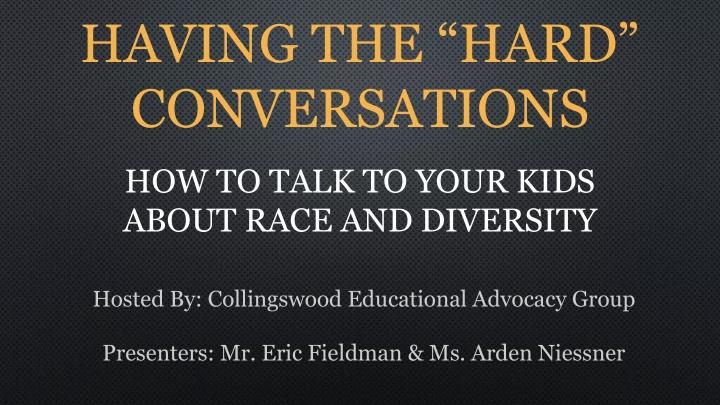

HAVING THE “HARD” CONVERSATIONS HOW TO TALK TO YOUR KIDS ABOUT RACE AND DIVERSITY Hosted By: Collingswood Educational Advocacy Group Presenters: Mr. Eric Fieldman & Ms. Arden Niessner
Consider the following statements and select the one that best describes how you feel: ~ I would rather not talk about race/racism. ~ I am very uncomfortable talking about race/racism. ~ I am usually uncomfortable talking about race/racism. ~ I am sometimes uncomfortable talking about race/racism. ~ I am usually comfortable talking about race/racism. ~ I am very comfortable talking about race/racism.
The hard part of talking about race/racism is …
The beneficial part of talking about race/racism is …
My own experiences of race taught me …
My children’s experiences of race are different from mine because …
Do you worry about your ability to answer children’s questions about race and racism? If so, commit to accepting that you don’t have all the answers, and embrace the opportunity to learn with your children.
Do you feel ill-prepared to talk about race and racism? If so, commit to learning more about the issues by studying history, following current events and brushing up on anti-racism work.
Do you reroute discussions when you sense resistance or anger in the room? If so, commit to riding out the discussion next time.
Do you feel isolated in your experience of race and racism? If so, commit to identifying a friend or family member with whom you can debrief and share .
Tips on How to Talk to Children About Diversity and Difference 1. Talk about diversity in the same way you would talk about safety. When it comes to teaching safety, most parents get it. You talk about safety, you demonstrate it, you ask your kids to spell it back to you. AND you don't care if it might seem a bit over the top. The priority is their safety. According to Marguerite Wright, psychologist and author of I'm Chocolate, You're Vanilla: Raising Healthy Black and Biracial Children, "If you don't acknowledge differences, you fail to prepare your child to live in a multiethnic society." That adage is true for gender identity, disability, Indigenous People and transphobia.
Tips on How to Talk to Children About Diversity and Difference 2. It's OK to be afraid, but get over it. It’s time to start getting comfortable with being uncomfortable.
Tips on How to Talk to Children About Diversity and Difference 3. Intentionally look for teaching moments and material. For the littlest children, simply pointing out skin colors and other attributes on the children in books can get kids noticing and appreciating differences. “This baby’s knees are brown,” or, “Look, her hair is puffy, isn’t that beautiful?”Books with lots of faces with different skin tones can be a natural way to enter into these conversations. These books are a great option if you are feeling intimidated by talking about race, since simply the process of reading these books introduces the concept of skin color.
Tips on How to Talk to Children About Diversity and Difference 4. Match the message to your audience. They’re never too young, and an ongoing dialogue about race and racism is a really good idea. Not talking about race and racism sends a message to children that this is a taboo topic. Each age group has different needs. Choose age appropriate books or materials that match your child's level of understanding
Tips on How to Talk to Children About Diversity and Difference 5. Accept that your child will say discriminatory things, and that doesn't mean your child is racist. Don't over-react to their comments or questions. BUT, don't ignore it either. There are also a few key phrases that will help: "Let's talk about that for a minute ..." "What made you notice that?" "What made you say that"
Tips on How to Talk to Children About Diversity and Difference 6. Teach your kids how to use inclusive language by discouraging and avoiding labeling. There is a subtle difference between referring to someone as the "Asian kid", versus "that child from Asia." And an even better phrase would be “that child with the Asian heritage.”
Tips on How to Talk to Children About Diversity and Difference 7. Break down "them and us" by pointing out similarities. When setting the stage for cross-cultural interaction or dialogue, the first goal is establishing a strong sense of commonality.
Tips on How to Talk to Children About Diversity and Difference 8. Seek out diversity in media. According to researchers on unconscious bias, exposure to counter-stereotypical images is the most impactful intervention of unconscious bias.
Tips on How to Talk to Children About Diversity and Difference 9. Don't over do it. Over-talking about anything (including safety) can actually cause adults and children to tune you out.
Tips on How to Talk to Children About Diversity and Difference 10. Model inclusive behavior and language. Ii If you say it’s important to have a diverse group of friends but your children don’t see a diverse group of people coming over to your home, they know you are not making it a priority in your life, so why should they? This also holds true for things like choosing to consume media that counters racial stereotypes or speaking out against racial inequities.
So: Don’t be afraid to have the conversation. Find out what they know Let them know they’re safe Admit your own biases Don’t be afraid to say “I don’t know!” Encourage open dialogue
Recommend
More recommend